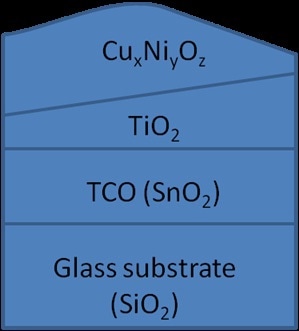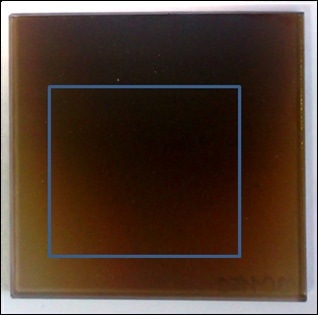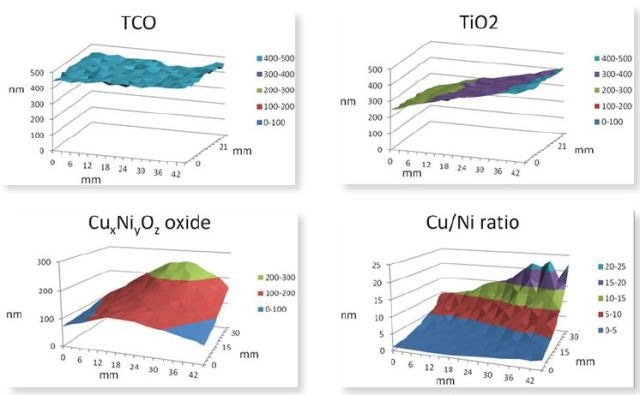Photovoltaic cells are an excellent option for generation of low-carbon renewable energy. However, traditional designs often include undesirable toxic compounds and need to be manufactured under special conditions.
The all-oxide approach to photovoltaic cells is highly attractive, as it overcomes many of these challenges, and offers potential method of creating an economical and more widely used product.
Oxford Instrument's AZtec LayerProbe was used for the analysis of a combinatorial library sample with differing layer thicknesses and compositions, so as to determine the most effective combination.
Composition and Thickness Measurements Using the AZtec LayerProbe
Layer thicknesses and compositions are measured with the Aztec LayerProbe by affixing a user-defined model of the sample to an EDS spectrum obtained using the software.
Since thickness and composition are calculated from an EDS spectrum obtained from the sample surface, LayerProbe is non-destructive. This permits subsequent testing and analysis of the sample, in this case, allowing the electrical performance to be correlated with layer properties.
The high spatial resolution of LayerProbe enables analysis of features down to 200nm with thickness between 2 and 2000nm. In order to achieve the best results, LayerProbe suggests the optimum SEM conditions for a given analysis.
Figure 1 shows the layer structure of the all-oxide solar cell stack and Figure 2 shows a photograph of the sample with the analyzed area indicated by the rectangle.

Figure 1. The layer structure of the all-oxide solar cell stack.

Figure 2. Photograph of the sample with the analysed area indicated by the rectangle.
Analysis of an All-Oxide Solar Cell Combinatorial Library
The sample studied here includes a glass substrate, a transparent conductive oxide (TCO) layer (Fluorine-doped SnO2), the active layers being a TiO2 layer with a constant thickness gradient and a top layer with varying CuxNiyOz composition and thickness.
The complete structure therefore forms a combinatorial library of PV devices, each with an innovative combination of active layer composition and layer thickness. 208 EDS spectra were obtained from the sample top over an area of 42x36mm for characterizing layers in the sample. The spectra were then processed using LayerProbe.
The starting model includes the layer sequence in the sample as well as the composition of all the layers except the CuxNiyOz. The parameters determined by LayerProbe were the thicknesses of the TCO and TiO2 layers, and the composition and thickness of the upper CuxNiyOz layer.
The results of the LayerProbe measurements are shown in the surface plots. The TCO layer thickness was constant across the measured area, whereas that of the TiO2 varied linearly along the horizontal axis. The CuxNiyOz layer thickness has a more complex profile corresponding to the shading which can be seen in the photograph of the sample (right).

Figure 3. Surface plots show the layer thickness obtained using LayerProbe of the TCO layer, the TiO2 layer and the CuxNiyOz layer respectively. The Cu/Ni ratio is that in the CuxNiyOz layer.
Conclusion
Using the LayerProbe has enabled the cost-effective and rapid quantification of layer thickness and composition at 208 points in a non-destructive manner. A large library of combinations has been studied in a single sample, since the combination of thickness and composition is different at each of these points.
This data, along with electro-optical characterization of individual solar cell devices enables the rapid testing and development of new material combinations, simplifying the process of developing highly economically viable devices and allowing them to be brought to market more rapidly.

This information has been sourced, reviewed and adapted from materials provided by Oxford Instruments Nanoanalysis.
For more information on this source, please visit Oxford Instruments Nanoanalysis.